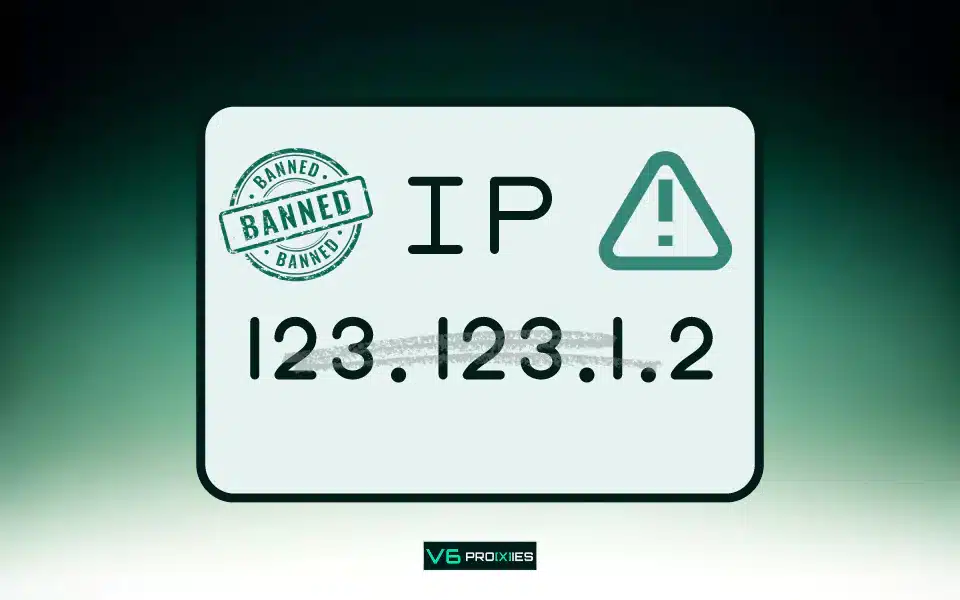The internet promises freedom, but what happens when unseen gatekeepers slam the door shut? IP bans are a digital power play, restricting your access and silencing your voice online. But there are ways to break free… So, let’s understand what IP bans are, why they happen, and how to get around them.
Table of Contents
A) What Is An IP Ban?
An IP ban is a digital roadblock. Websites, online services, or entire networks can implement it to deny access to devices with a specific IP address. Think of your IP address as your online mailing address – an IP ban essentially puts your address on a “no delivery” list.
B) Why Do IP Bans Exist?
It is important to note that IP bans aren’t always a punishment. Reasons for IP bans and IP blocking implementation include:
1. Security
To block hackers, spammers, or other malicious actors who consistently attack from a specific IP. Examples include:
- Instagram Example: An IP address might be banned from Instagram if it’s used to attempt multiple logins with stolen credentials, indicating a hacking attempt.
- YouTube Example: An IP address used by YouTube sub bot, if YouTube detects it, could be banned from YouTube.
2. Rule Enforcement
Websites, forums, and gaming communities use IP bans to maintain order and prevent disruptive behavior.
- Instagram: An IP address could be banned from Instagram for repeatedly leaving spam comments, using hate speech, or engaging in bot-like behavior on Instagram (excessive liking/following).
- Ticketmaster: An IP address might be banned from Ticketmaster if associated with scalping activity (using bots to purchase large quantities of tickets for resale).
- A gaming platform might IP ban a player who repeatedly uses hacks or exploits to gain an unfair advantage. See our guide on gaming proxies to learn more.
- A forum might IP ban someone for constantly posting offensive content or harassing other users.
3. Resource Management
In rare cases, websites with limited capacity might temporarily ban IPs to reduce traffic load.
- File-sharing websites as an example: A small file-sharing website might temporarily ban an IP address that’s downloading an excessive amount of data in a short period. This helps prevent a single user from hogging bandwidth and slowing down the experience for others.
C) Other Reasons Your IP Could Be Banned For
- Disruptive Online Behavior: Sending spam, trolling, harassment, or violating a website or community’s rules can lead to bans.
- Security Concerns: Your IP might be banned if it’s linked to repeated failed login attempts, attempts to exploit a website, or distribute malware.
- Automated Activity: Excessive use of bots or programs that scrape website data can violate terms of service and trigger IP bans.
- The “Bad Neighbor” Effect: If you’re using a dynamic IP address or public Wi-Fi, you could be inadvertently banned due to the actions of another user sharing the same IP.

D) How IP Bans Work
Every device connected to the internet has a unique IP address, much like a digital postal address. Websites and online services use various methods to track IP addresses, then store the data in blacklists.
Methods of identifying the ip address of sers include:
- Server logs: When you visit a website, its server records your IP address.
- Cookies: Small data files that websites store on your device can hold your IP address for identification.
- Analytics tools: Websites use analytics platforms that capture user data, including IP addresses.
And when a website or service decides to implement an IP ban, they add the targeted IP address (or a range of addresses) to a blacklist. Here’s how these IP blacklists work:
- Database or file: Blacklists can be simple text files or more sophisticated database systems.
- Matching and blocking: When a user tries to access the site, their IP address is checked against the blacklist. If there’s a match, their connection is refused.
E) Types of IP Bans
In understanding IP bans, it’s crucial to consider how they vary in terms of duration and scope.
Temporary vs. Permanent Bans
Think of temporary bans as a digital timeout. Websites often implement these for first-time or minor offenses, like a user spamming comments on a forum. They also serve as a deterrent against automated activities, such as bots scraping data or overloading a website.
What’s key about temporary bans is their temporary nature; they lift automatically after a set duration, ranging from a few hours to several weeks, depending on the offense’s severity.

On the other side of the spectrum are permanent bans. These represent a much more serious restriction, typically reserved for repeat offenders who continue to violate rules despite warnings, or for those committing severe violations like hacking attempts or distributing harmful content.
It’s not always a one-way street, though. Some platforms offer an appeal process, but lifting these bans heavily depends on their policies and the nature of the violation.
Individual IP vs. IP Range Bans
The distinction between individual IP and IP range bans hinges on the precision of targeting. Individual IP bans act like a surgical strike, addressing the problem at its most specific point. For instance, if a single user persistently makes abusive comments on a forum, a ban targeting their specific IP address would prevent further misuse from that particular connection.
Contrastingly, IP range bans cast a wider net. They are more comprehensive and, sometimes, carry unintended consequences. This approach is common when dealing with known spammers operating from certain IP ranges, or in scenarios where services need to enforce regional restrictions due to legal reasons or to prevent targeted attacks from certain geographic locations.
While effective in certain scenarios, IP range bans risk blocking access to innocent users sharing the same range/subnet, highlighting the need for careful consideration in their application.
Important Considerations
- Dynamic IP addresses: Many home internet connections use dynamic IPs, which can change periodically. This can lead to innocent users being caught in IP bans meant for someone else.
- Circumvention: While IP bans are a deterrent, determined users can sometimes find ways around them, such as with proxies or VPNs.
F) How to Check If You’re Banned
Spotting the signs of an IP ban isn’t always straightforward. Here’s what to watch for:
Signs and Symptoms:
- Direct error messages that mention “banned,” “blocked,” or “restricted access.”
- Inability to load specific websites or use certain online services that worked previously.
- Unusual slowdowns or timeouts when trying to connect.
Tools To Check If Your IP Is Banned
Several websites specialize in checking if your IP address is listed on common blacklists. These can give you a good indication of a possible ban through an IP fraud score. Popular options include:

G) How to Get Around an IP Ban?
To navigate around an IP ban, you have several options, each with its unique approach and level of effectiveness:
1. Wait For Some Time
For a temporary ban, the simplest solution is patience. These bans typically expire after a set period, so waiting for them to lift often works best.
2. Contact Support
If you believe the ban is a misunderstanding, try contacting the website or service’s support team. Explaining your situation and appealing the ban can lead to its removal, especially if it was a mistake.
3. Change Your IP Address
Changing your IP address is another method. Restarting your router often works for dynamic IPs, as it can assign a new address. Alternatively, you could request a new IP from your Internet Service Provider (ISP).
4. Use a VPN (Virtual Private Network)
Using a VPN (Virtual Private Network) offers a more technical solution. A VPN hides your real IP address by routing your internet connection through a different server. When choosing a VPN, it’s important to pick a reputable service for better security and reliability. CHECK the best 5 residential VPN providers in this guide.
5. Use A Proxy Server
Using a proxy server can be an effective method to circumvent an IP ban. While it’s true that proxies don’t typically encrypt all your data like VPNs, they serve a valuable purpose by rerouting your internet connection. This rerouting happens through a different server, providing you with a new IP address.
As a result, you can access websites or services that may have banned your original IP. It’s important to choose between free and paid proxy services wisely. Paid proxies often offer more reliability, speed, and security compared to free options, making them a more effective choice for consistent use.
Related: What is a proxy browser?
H) How To Prevent Future IP Bans
To avoid future IP bans, it’s essential to adhere to best practices that ensure responsible and secure online behavior. Here are some key strategies:
- Respect Terms of Services: Always follow the rules and guidelines of websites and platforms. This compliance is crucial in preventing violations that could lead to an IP ban.
- Secure Your Accounts: Use strong, unique passwords for each of your online accounts. This step helps prevent unauthorized access that could result in suspicious activities leading to an IP ban.
- Be Cautious on Public Wi-Fi: Public networks can be less secure. Ensure that your activities on these networks do not violate any terms of service, as public IP addresses can sometimes attract bans due to the activities of other users on the same network.
Limit Automated Activities: Be mindful of using bots or automated services and only do it from a masked IP or using a pool of proxy IPs. If a platform restricts automated actions, exceeding these limits can trigger an IP ban.



